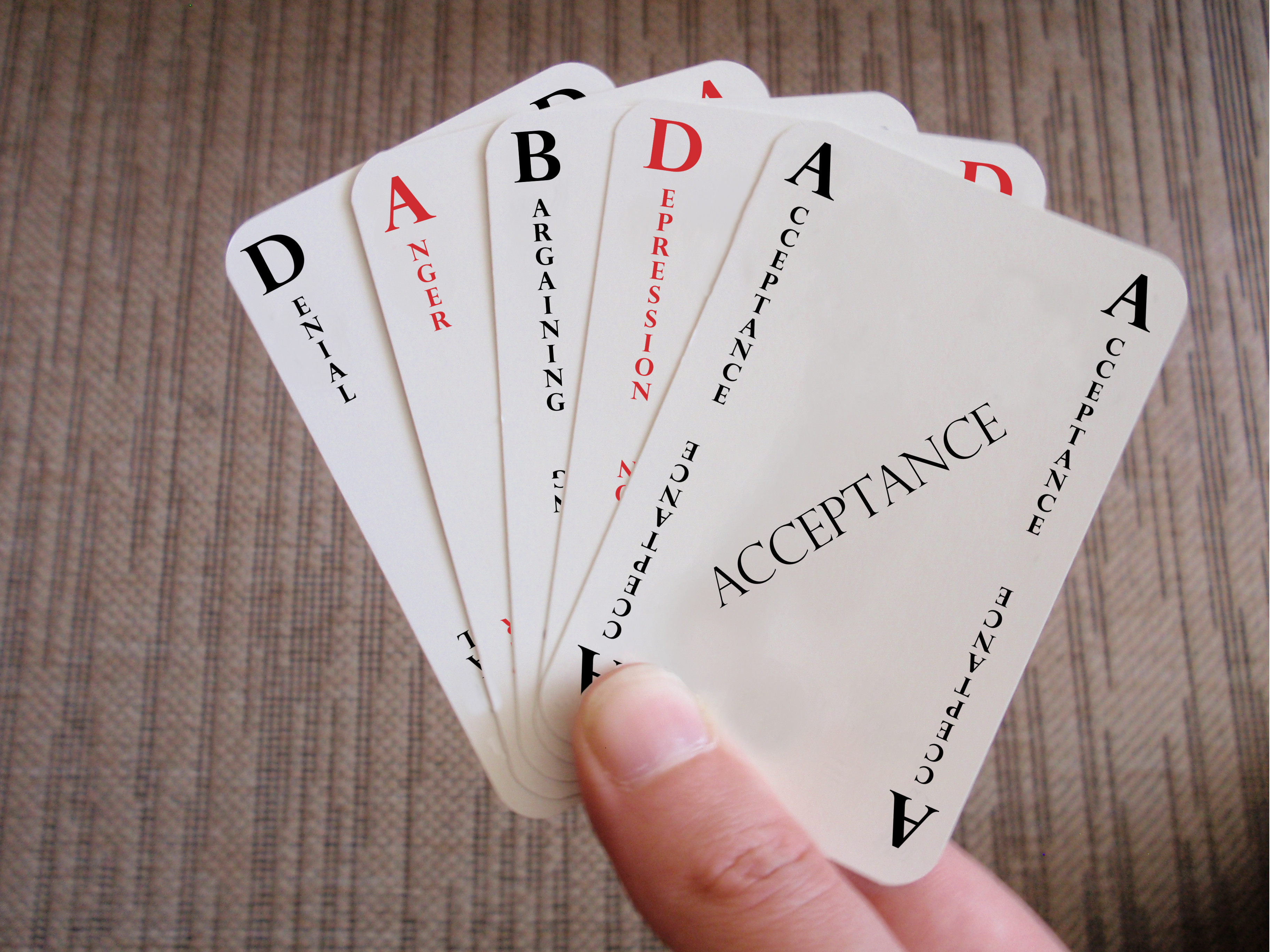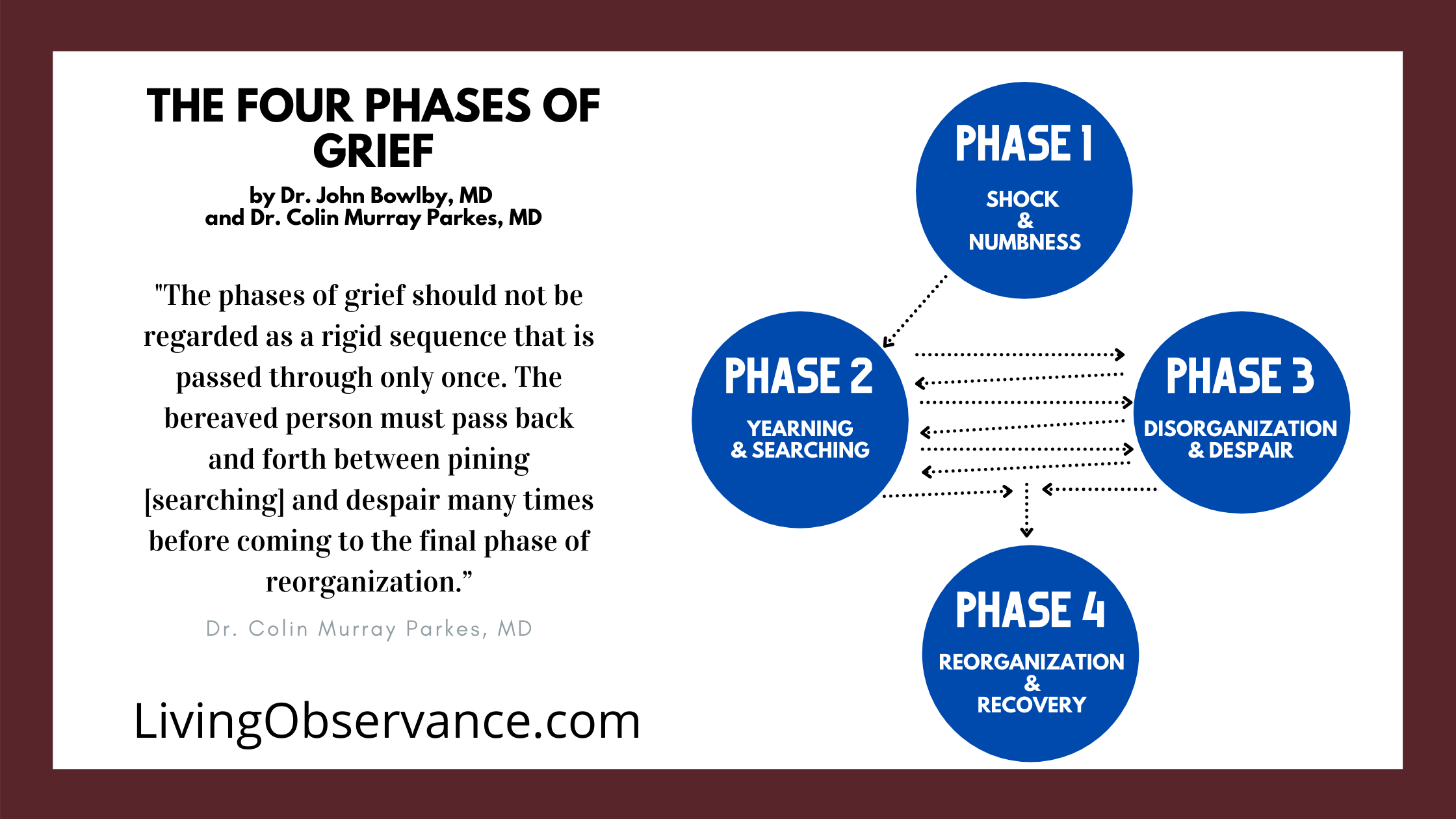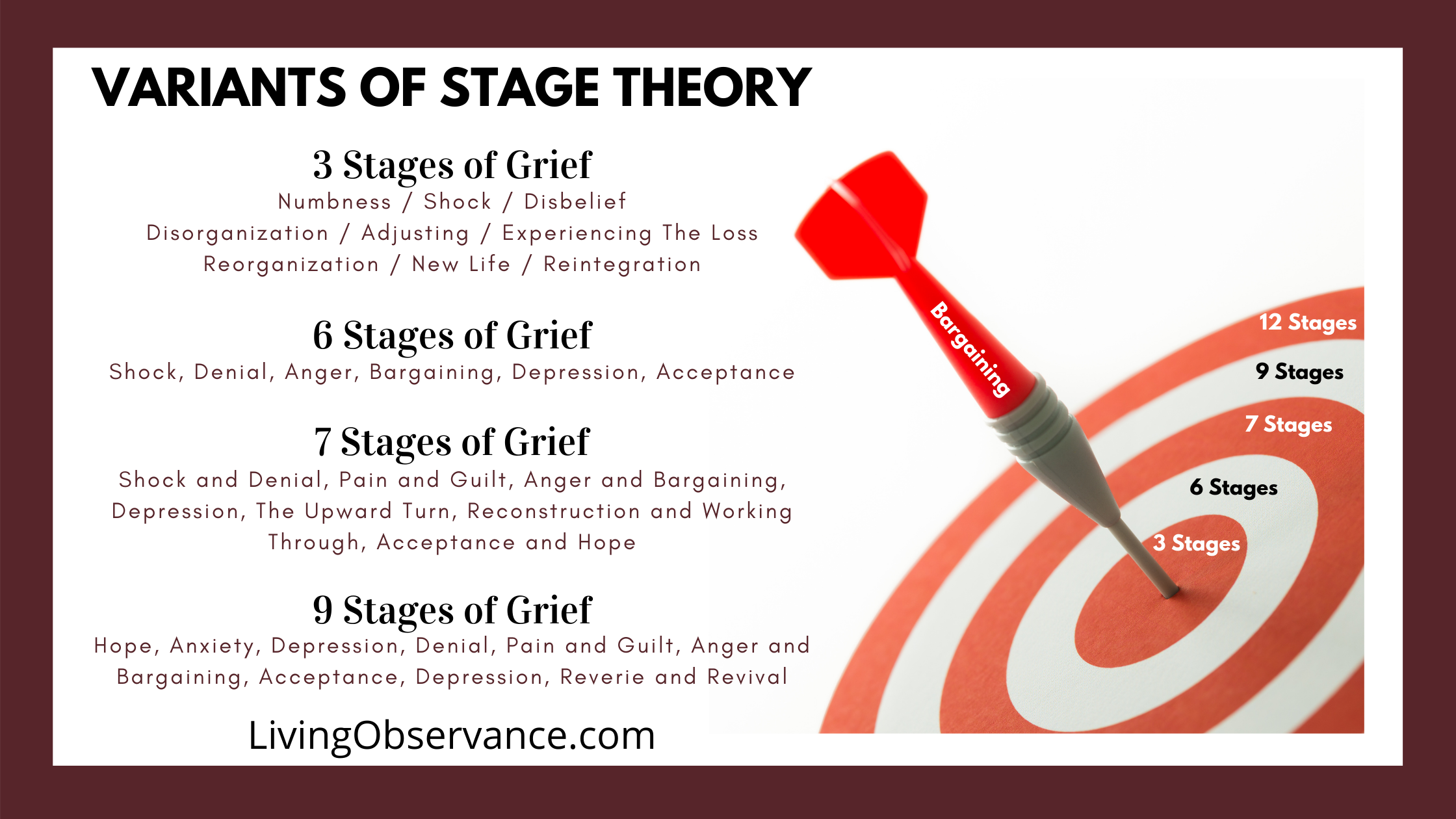At a Glance
An Overview of the Stages of Grief
In this article I’ll share with you what I learned. Before we jump into Stage Theory I want to insert one disclaimer. The grief that we all feel is incredibly unique.
Talented Professionals and Academics dedicate enormous amounts of time to understanding how we grieve. When one of them notices a pattern, they will start to investigate the pattern. If the pattern looks to be true across a wide variety of a specific population then the pattern is turned into a theory.
None of the theories around grieving are 100% applicable to everyone. You may find that some aspects of one theory apply to you while others don’t fit into your experience at all.
Stage Theory is a tool that you can use to begin shaping your own understanding of grief, but it is not the only theory you should follow. The stages of grief acted as a diving board in my own journey of learning about grief, and I hope that this article can help you on your journey.
A Brief Introduction To Stage Theory
The stages of grief, or formally known as Stage Theory, is a method of categorizing the recovery process after a traumatic experience. The basic idea is that after a person loses someone that they will go through a series of generalized stages. At each one of the stages the bereaved person needs a specific kind of support in order for them to progress to the next stage. By successfully completing each stage a person is able to move past their grief and recover from their loss.
Due to the varying and complex nature of grief it is challenging for regular people to know how to process their own emotions following a loss. Stage Theory is a major subject in popular grief education due to its concise and easy to understand explanation.There are several variations to the original presentation, but the end goal is the same.
Common Misunderstandings About The Stages Of Grief
As with any technical subject that has been widely adopted by popular culture, there are several misconceptions about the stages of grief. Before we can dive into what the stages are, we need to talk about what the stages are not. This will provide us with a framework to understand the intention of each theory.
A “Normal” Grieving Experience
There is no such thing as a “normal” grieving experience. Every person will have their own and unique experience when they grieve. The more you talk to others about their experiences, the more you will see common themes occur, but that does not make the experiences identical.
The stages that are in each of the theories below are the most common themes that the authors have found in their research and conversations. Just because the themes are the most common doesn’t mean that they are universal.
If your experience doesn’t align with the stages we will cover, that is okay. That is normal. You are still grieving successfully and on the road the healing. These stages are only large buckets to help us organize extremely complex thoughts about a mysterious experience.
Descriptive vs Prescriptive
All of the stages of grief are only descriptions of what people might experience. This is a critical misunderstanding that can cause significant pain and complications for bereaved people. The stages of grief should never be used to forecast someone’s recovery process or used as gates to force bereaved people through.
As people grieve, these stages can serve as a way to help them express their current state in the grieving process. The stages can help them to categorize new feelings that they may never have experienced before.
Moving Through The Stages
Because of how simply stage theory lays out the grieving process, it is easy to believe that the sequences presented are the correct order we should be experiencing. The reality is that we may experience more than one stage at the same time. We may experience the stages in a different order. We may never experience some of the stages.
We all will grieve in our own way and on our own schedule. There is no way to force ourselves (or others) to move through the stages in a specific order or at a pace other than what we need.
Timeline Of Grief Process
There is no standard amount of time that someone may be grieving. Bereaved people will often report that they feel they are recovering in the second year, but grief can last much longer.
Yale did a study on bereavement that followed over 200 people bereaved people over the course of 24 months. The study concluded that most of the stages that are filled with intensely negative feelings will peak at 6 months as acceptance gradually increases over the next 24 months.
Variations of the Stages Of Grief
Stage theory was originally developed in 1969. Dr. Elisabeth Kübler-Ross, MD, was the first person to present the idea of stages of grief. Dr. Kübler-Ross opened the door to conversations about dying and grieving. Since that time there have been many variations of her original idea.
5 Stages of Grief (also known as the Kübler-Ross model or DABDA model)
You can find out more about the Five Stages of Grief from the Journal of American Osteopathic Association
Stage Theory was developed by Dr. Kübler-Ross after she interviewed around 200 of her patients that were terminally ill and dying. Throughout her conversations she noticed a repeating pattern that nearly all of her patients experienced. She documented her findings and published them in a book called "On Death and Dying", which was published in 1969.
Her work was focused on describing the grief the people experience as they are facing the end of their own life. She suggests that by identifying the various stages that someone is in, healthcare professionals and supporting people will be able to provide the specific care that is necessary. The stages also help those who have never been through such an intense experience as facing your own mortality to empathize with the grieving person.
Dr. Kübler-Ross originally suggested that there are five stages that people will go through sequentially. Later she clarified that there are bridge stages and that some stages may be experienced simultaneously or in preparation for the following stage.
The Five Stages Of Grief Are:
Denial - When a person believes that the painful information they received is not true. If they do believe the information, they may put undeserved confidence into alternative methods of correcting the problem. Dr Kübler-Ross suggested that in order to support the person, we should not try to prove them wrong or argue with them. Instead, the person needs to fully experience denial.
Anger - When the person accepts the painful information and recognizes that the plans they had previously can’t happen anymore. The person may also have unfinished business that they are unable to complete. The person may focus that frustration at healthcare professionals or those that are close to them. People that are in the Anger stage need to be granted as much control as possible. If they can feel in control of something in their life, then they will start to feel in charge of their remaining life.
Bargaining - After the person feels that they have some control in their future, they will bargain for more time to live. Usually the bargaining stems from guilt. The target of the bargaining is usually either a physician or a higher power. Dr. Kübler-Ross believed that people that are bargaining need to be heard. They will tell you what they need to find closure. To support the person, we should do what is reasonable to help them fulfill these needs. It may be something as simple as contacting someone in their life.
Depression - As the person recognizes that death is more likely they will move into the depression stage. The depression may be in preparation of death, or perhaps something that the person has already lost. If the person is willing, it is important to let them share their worries and feelings. The person needs to be heard more than anything else at this stage.
Acceptance - After completing all of the other stages, the person will accept their fate. They may start to speak more openly about their death and current feelings. Like the depression stage, the best way to support someone that has accepted their future is to be a good listener. Dr Kübler-Ross suggests that patients that don’t keep their feelings bottled up tend to pass away more peacefully.
4 Stages of Grief (primarily known as the Four Phases of Grief)
Read more about the Four Phases of Grief from the University of Colorado
The Four Phases of Grief were designed by Dr. John Bowlby, MD and Dr. Colin Murray Parkes, MD in 1980. Dr. Bowlby brought his experience in attachment theory and Dr. Parkes contributed his experience with human information processing to create the foundation of the four phases of grief. While the five stages of grief focus on facing one’s own end of life, the four phases document the grief process for the survivors of someone that passes away.
They suggest that grief is not simply a series of gates to pass through before reaching full recovery. In his 1998 article “Coping with loss, Bereavement in adult life”, Dr Parkes says, “...the phases of grief should not be regarded as a rigid sequence that is passed through only once. The bereaved person must pass back and forth between pining [searching] and despair many times before coming to the final phase of reorganization.”
The Four Phases Of Grief Are:
Shock and Numbness - When a loved one passes away, the survivor will experience a period of shock that evolves into a numbness that can last for a few hours or days. This numbness is a natural coping mechanism that allows the survivor to continue functioning during the period of immense pain.
Yearning and Searching - Shortly after the first phase, a survivor will start to experience strong feelings of yearning for the deceased and anxiety about life without that person. In this phase people are able to take care of basic functions and responsibilities.
Disorganization and Despair - The survivor will start to reflect on the loss and all of the events preceding it. This reflection is usually done in a way where the survivor is wondering if there is anything that they could have done to change the outcome of the death. There may also be a feeling that the person that passed away is still nearby. A survivor may feel that they see or hear the deceased during times of great drowsiness.
Reorganization and Recovery - As the survivor experiences fewer cycles of Phase 2 and Phase 3 they will eventually begin to reinvest their energy into forging a life routine that doesn’t include the deceased. The survivor’s feelings of grief surrounding the loss of their loved one are slowly replaced by positive ones.
3 Stages of Grief
You can read more detailed information about the three stage model at ElderCareOnline.net
The Three Stages of Grief model is a simplified version of stage theory by Dr. Roberta Temes Ph.D. in 1992. She presented the three stage model in her book, "Living with an Empty Chair: A Guide Through Grief". Dr. Temes work provided a much flexible framework for a bereaved person. There have been several variations of the three stage model, but they all fall in line with the original model.
The Three Stages Of Grief Are:
Numbness / Shock / Disbelief
Disorganization / Adjusting / Experiencing The Loss
Reorganization / New Life / Reintegration
6 Stages, 7 Stages, 9 Stages, and 12 Stages of Grief
When searching on the internet for “Stage of Grief” there are several variations that will come up. Many of these are slight redesigns or combinations of the 4 and 5 stage models.
6 Stages of Grief
This model adds a stage of “Shock” before the 5 Stage model.
The Six Stages Of Grief Are:
Shock, Denial, Anger, Bargaining, Depression, Acceptance
7 Stages of Grief
Read more about the 7 stage model at Healthline
The Seven Stages Of Grief Are:
Shock and Denial, Pain and Guilt, Anger and Bargaining, Depression, The Upward Turn, Reconstruction and Working Through, Acceptance and Hope
9 Stages Of Grief and 12 Stages of Grief
The 9 and 12 stage models of grief are not as widely popularized. These primarily relate to models of grief specifically related to grief induced by divorce. There is a 9 stage model of grief that has been written about in detail by Mike Takieddine.
The 9 Stages Of Grief Are:
Hope, Anxiety, Depression, Denial, Pain and Guilt, Anger and Bargaining, Acceptance, Depression, Reverie and Revival
Conclusion:
Grief theories are constantly developing and adapting to the new information that we learn. There most likely isn’t going to be a single theory that matches all of your experiences, but there will be several that touch some aspect of your journey. The more touchpoints you encounter, the more you will understand yourself and, more importantly, what your needs are to heal.
Stage theory is popular because of its incredible simplicity. This simplicity is one of the major criticisms. Take a look at our other article on the Top 4 Criticisms of the Stages of Grief. This is a great place to begin learning about your own grief, but it is not the only theory that is out there. Later this month, I will publish an article lightly exploring some of the other theories and more actionable frameworks. Join us on our knowledge & healing journey by subscribing to our mailing list. By subscribing you will guarantee that you won’t miss out on any of our new articles and you will receive a sneak peek of the next week's posts.




